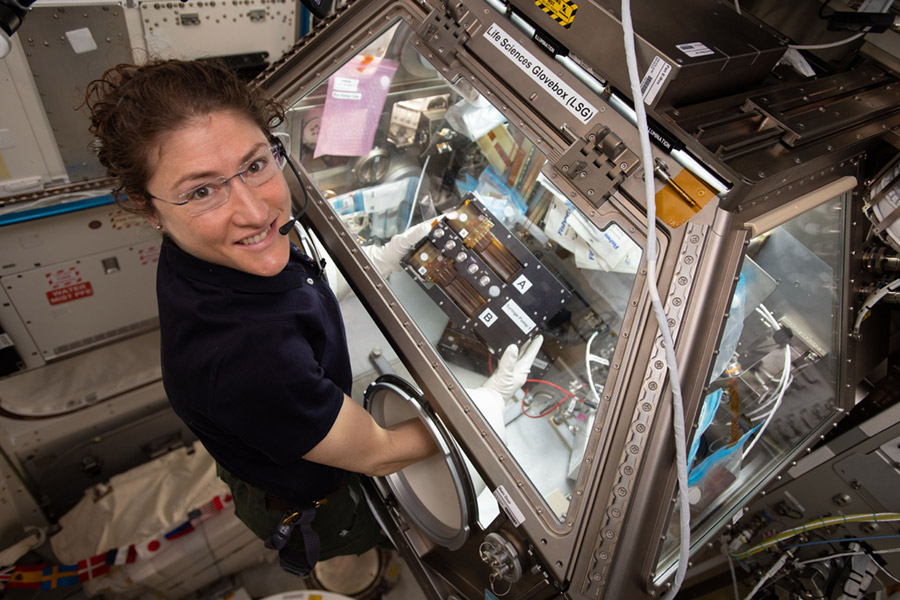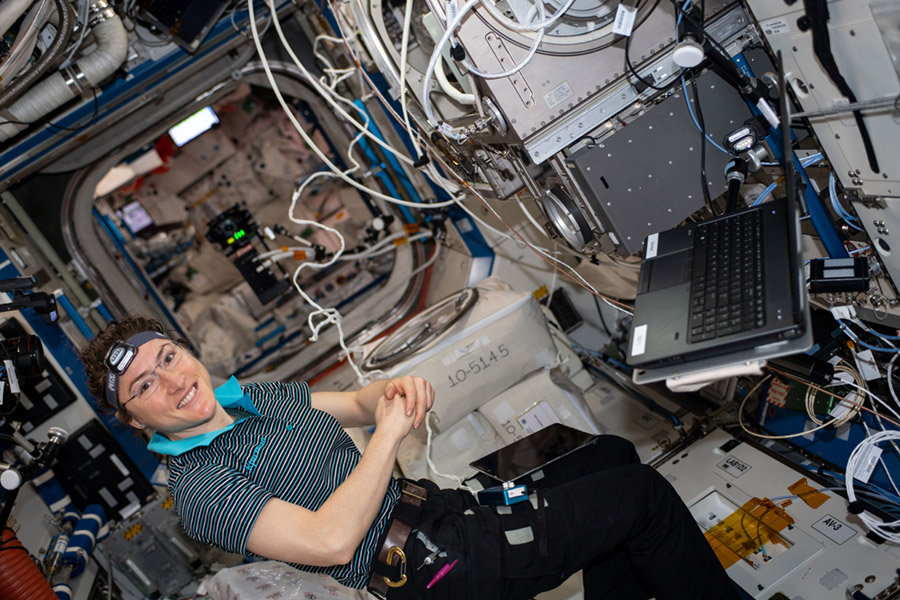NASA Astronaut Christina Koch to Return From Record-Setting Mission

Expedition 59, 60, and 61 Flight Engineer Christina Koch of NASA works inside the Quest joint airlock preparing spacesuits for work outside the space station. Koch performed five spacewalks during her 11-month mission.
Media Credit: NASA
February 4, 2020
NASANational Aeronautics and Space Administration astronaut Christina Koch is returning to Earth later this week after a record-setting mission onboard the International Space Station (ISSInternational Space Station). Koch launched to the ISS in March 2019, and her extended time on station set a record for the longest single spaceflight by a woman. Koch also conducted the first all-woman spacewalk with fellow ISS crew member NASA astronaut Jessica Meir.
During her time in orbit, Koch worked on an immense amount of research sponsored by the ISS U.S. National Laboratory—ranging from the life and physical sciences to materials science, remote sensing, technology development, and education. Below highlights some of the many ISS National Lab investigations Koch worked on while onboard the ISS.

Expedition 60 flight engineer Christina Koch of NASA uses a microscope to observe and photograph growing protein crystal samples as part of the MicrogravityThe condition of perceived weightlessness created when an object is in free fall, for example when an object is in orbital motion. Microgravity alters many observable phenomena within the physical and life sciences, allowing scientists to study things in ways not possible on Earth. The International Space Station provides access to a persistent microgravity environment. Crystals experiment onboard the ISS.
Media Credit: NASA
This investigation aims to crystalize a membrane protein that is involved in tumor formation and cancer survival and is implicated in the progression of multiple diseases, including Parkinson’s, Alzheimer’s, type 2 diabetes, and obesity. Learn more here..

Koch works inside the Life Sciences Glovebox conducting research for the Kidney Cells Tissue Chips in Space investigation.
Media Credit: NASA
This investigation aims to study tissue-on-a-chip systems modeling the human kidney to understand the body’s use of Vitamin D, the disease proteinuria, and kidney stone formation. Learn more here.

Koch activates the new BioFabrication Facility(Abbreviation: BFF) The BFF is a 3D bioprinter on the ISS capable of printing human tissue from bioinks mixed with living cells. This ISS National Lab commercial facility is owned and operated by Redwire Space. to test its ability to print cells. Researchers are exploring whether the weightless environment of space may support the fabrication of human organs in space.
Media Credit: NASA
This investigation seeks to complete the Preliminary Design Review for a space-based, automated tissue and organ printing system capable of cell culture. Learn more here.

Koch and NASA astronaut Jessica Meir working on the Rodent Research-14 investigation from Baylor College of Medicine examining circatidal gene expression
Media Credit: NASA
This project studies how exposure to microgravity disrupts the circatidal clock, the 12-hour oscillation of genes involved in metabolism, to explore the role of regulatory genes in metabolic disorders such as liver disease, diabetes, and other illnesses associated with obesity. Learn more here.

Koch working on the Rodent Research Reference-2 mission onboard the ISS.
Media Credit: NASA
Rodent Research Reference Missions, which supplement traditional single-investigator rodent research missions, provide multiple investigators access to biospecimens from a single mission. Learn more here.

Koch sets up Fiber Optic Production, an investigation to create optical fibers in microgravity that may exhibit superior quality to those produced on Earth.
Media Credit: NASA
This study seeks to draw high-quality ZBLAN optical fibers in microgravity using Physical Optics Corporation’s Orbital Fiber Optic Production Module. Learn more here.

Koch works on the Genes In Space-6 experiment.
Media Credit: NASA
The Genes in SpaceAn annual national research competition for students in grades 7 through 12 to design pioneering biotechnology experiments that are conducted by astronauts on the space station. The program is funded by Boeing and miniPCR bio and supported by the ISS National Laboratory® and New England BioLabs. program, founded by Boeing and miniPCR and supported through the ISS National Lab, holds a free annual competition for students in grades 7 through 12 to propose pioneering DNA experiments that use the unique environment of the ISS.
This student investigation aims to improve understanding of microgravity’s effects on the mechanisms of DNA repair, using DNA amplification with a miniPCR (polymerase chain reaction) machine and DNA sequencing onboard the ISS. Learn more here.

Koch preparing to run code from participants of the SPHERES Zero Robotics 2019 Middle School Summer Program.
Media Credit: NASA
Developed by the Massachusetts Institute of Technology in 2009, Zero Robotics is a competition in which middle school and high school students program small robots called SPHERES (Synchronized Position Hold Engage and Reorient Experimental Satellites) that operate inside the ISS. Learn more here.

Koch works on the PCG 15 investigation, with results that could contribute to the identification of biomarkers for diagnosis of disease and to the development of better antimicrobials.
Media Credit: NASA
This experiment aims to produce larger and higher-quality crystals of three medically relevant proteins, toward structure determination of the proteins. Learn more here.